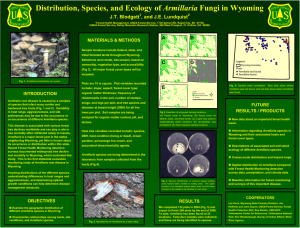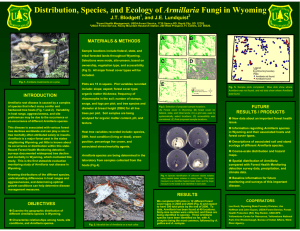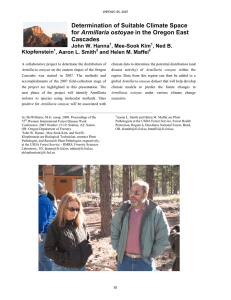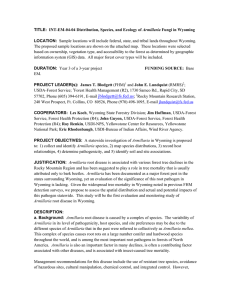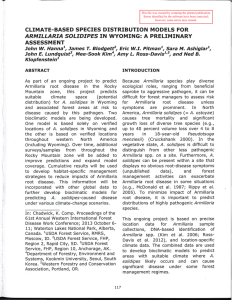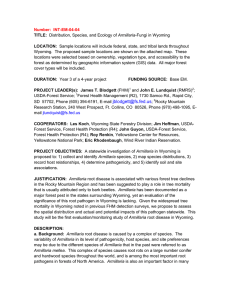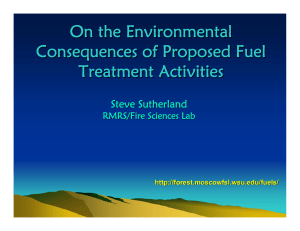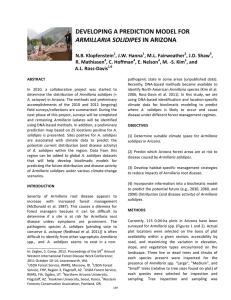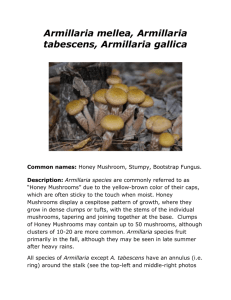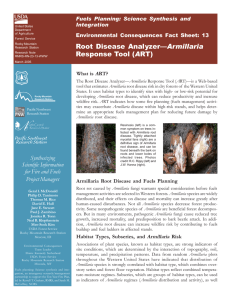Armillaria J.T. Blodgett , and J.E. Lundquist
advertisement
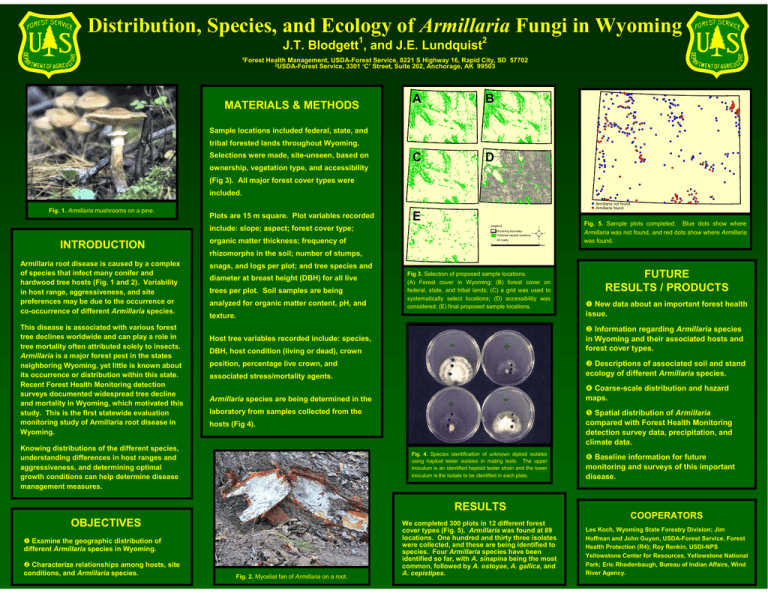
Distribution, Species, and Ecology of Armillaria Fungi in Wyoming 1 2 J.T. Blodgett , and J.E. Lundquist 1Forest Health Management, USDA-Forest Service, 8221 S Highway 16, Rapid City, SD 57702 2USDA-Forest Service, 3301 ‘C’ Street, Suite 202, Anchorage, AK 99503 MATERIALS & METHODS A D E Legend: N Wyoming boundary. Potential sample locations. INTRODUCTION Armillaria root disease is caused by a complex of species that infect many conifer and hardwood tree hosts (Fig. 1 and 2). Variability in host range, aggressiveness, and site preferences may be due to the occurrence or co-occurrence of different Armillaria species. This disease is associated with various forest tree declines worldwide and can play a role in tree mortality often attributed solely to insects. Armillaria is a major forest pest in the states neighboring Wyoming, yet little is known about its occurrence or distribution within this state. Recent Forest Health Monitoring detection surveys documented widespread tree decline and mortality in Wyoming, which motivated this study. This is the first statewide evaluation monitoring study of Armillaria root disease in Wyoming. organic matter thickness; frequency of All roads. 80 0 W E S 160 S # S # S # # #S S #S S # S #S # S # S ##S S # S # S # S # S #S S # # S # S # S # S # S # S # S # S # S #S # S # S # S #S # S # S ## S # S #S S # S # S # S ## S # S # S #S # S #S #S S # # S #S S # S # S # S # S # S # S # S # S # S # S # S # S # S # S # S # S # S # S # # S #S S # S # S # S # # S #S S # # S #S S ## S S #S # S # #S # S # S S # S #S # # S # S S # S # S # S # S # S # S # S # S # Armillaria not found. Armillaria found. S # S #S # S ## S # S # S # S S #S S # #S # S # S # S # S # # # S S #S S # # S #S #S # # S S #S S # # S #S S # Fig. 5. Sample plots completed. Blue dots show where Armillaria was not found, and red dots show where Armillaria was found. Miles rhizomorphs in the soil; number of stumps, snags, and logs per plot; and tree species and diameter at breast height (DBH) for all live trees per plot. Soil samples are being analyzed for organic matter content, pH, and Fig 3. Selection of proposed sample locations. (A) Forest cover in Wyoming; (B) forest cover on federal, state, and tribal lands; (C) a grid was used to systematically select locations; (D) accessibility was considered; (E) final proposed sample locations. texture. FUTURE RESULTS / PRODUCTS n New data about an important forest health issue. o Information regarding Armillaria species in Wyoming and their associated hosts and forest cover types. Host tree variables recorded include: species, DBH, host condition (living or dead), crown associated stress/mortality agents. p Descriptions of associated soil and stand ecology of different Armillaria species. Armillaria species are being determined in the q Coarse-scale distribution and hazard maps. position, percentage live crown, and r Spatial distribution of Armillaria compared with Forest Health Monitoring detection survey data, precipitation, and climate data. laboratory from samples collected from the hosts (Fig 4). Knowing distributions of the different species, understanding differences in host ranges and aggressiveness, and determining optimal growth conditions can help determine disease management measures. Fig. 4. Species identification of unknown diploid isolates using haploid tester isolates in mating tests. The upper inoculum is an identified haploid tester strain and the lower inoculum is the isolate to be identified in each plate. RESULTS OBJECTIVES n Examine the geographic distribution of different Armillaria species in Wyoming. o Characterize relationships among hosts, site conditions, and Armillaria species. # S #S S # S # S # #S S #S #S # #S # S S # # S #S # S S #S # S # # S S #S #S ## S # S # S # S S # S # S # S # S # S # S # # S #S included. include: slope; aspect; forest cover type; S # S # S # (Fig 3). All major forest cover types were Plots are 15 m square. Plot variables recorded S # S # S #S #S # #S #S #S S #S # #S #S # #S S #S S # #S #S S #S #S #S # #S # #S # S S # S #S S #S S # S # S ## S # S # S # S # # S #S S # S # # S #S S #S S ## S S #S S # #S # S # #S # S # S # S # S # S # S #S # S # #S # S # S # S # S #S S #S S # S # S # #S #S #S # S # S # S # S # S # S # S S #S # # # #S S #S S # S # S # S # #S S #S # S #S # S # # S #S S # S # S #S S # S #S # # S # #S # S # #S S # S S #S # #S S # # S # S S # ownership, vegetation type, and accessibility Fig. 1. Armillaria mushrooms on a pine. S # S # tribal forested lands throughout Wyoming. C S # S # S # Sample locations included federal, state, and Selections were made, site-unseen, based on S # S # B Fig. 2. Mycelial fan of Armillaria on a root. We completed 300 plots in 12 different forest cover types (Fig. 5). Armillaria was found at 89 locations. One hundred and thirty three isolates were collected, and these are being identified to species. Four Armillaria species have been identified so far, with A. sinapina being the most common, followed by A. ostoyae, A. gallica, and A. cepistipes. s Baseline information for future monitoring and surveys of this important disease. COOPERATORS Les Koch, Wyoming State Forestry Division; Jim Hoffman and John Guyon, USDA-Forest Service, Forest Health Protection (R4); Roy Renkin, USDI-NPS Yellowstone Center for Resources, Yellowstone National Park; Eric Rhodenbaugh, Bureau of Indian Affairs, Wind River Agency.
